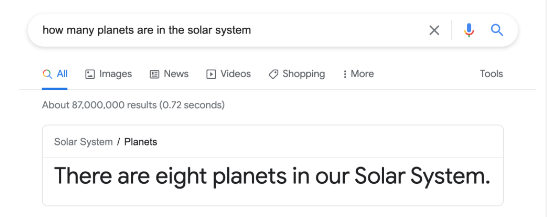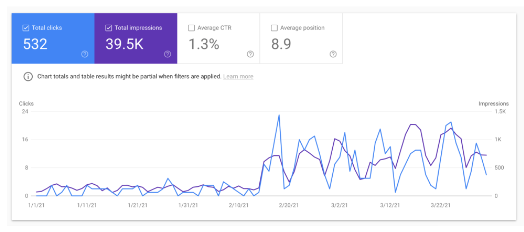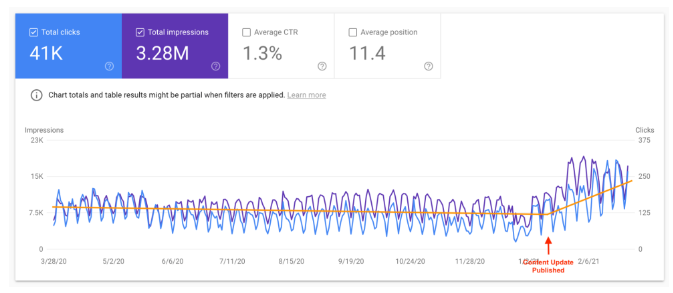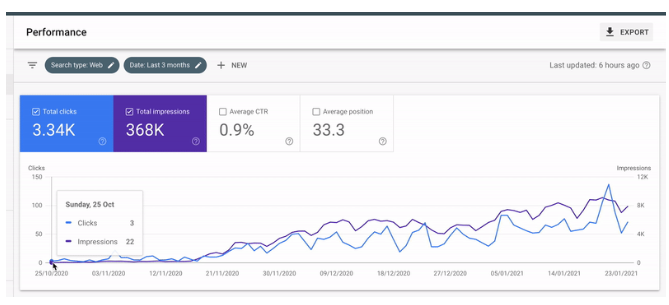The State of SEO in 2021: Insights From 15 SEO Experts
For many years, SEO has long been considered a vital part of the overall marketing strategy at many businesses.
However, as is the case with the state of content marketing (and marketing in general), the way we go about SEO has been changing. It seems that there’s a new algorithm update every few months, making search rankings seem unpredictable and chaotic.
To create this industry report, I interviewed 15 SEO experts to get their take on the State of SEO in today’s business landscape.
The good news is that, despite these changes, the quality of search results is improving.
People using search engines are getting better information. This does raise the bar of how valuable and actionable your content ought to be, though.
As Dan McLean at Vendasta Technologies states, “It’s so much tougher to rank for authority. Quality really matters, which is a good thing for us. That’s where we try to be laser-focused.”
In this report, we’ll take a deep dive into what SEO looks like now and what the future might hold for this critical yet fluctuating marketing channel.
So, let’s get to it.
How Has SEO Changed Over the Past Few Years?
The Senior SEO Manager at ClickUp, Jeremy Galante, believes that many experts agree that SEO has become increasingly complex over the last several years. There are more elements to focus on, question, and test, such as the new Core Web Vitals, including user experience and page load speed.
Below are some findings related to the evolution of SEO for you to consider.
1. More Emphasis on User Experience
In recent months, Google is putting greater emphasis on user experience, particularly for users of mobile devices. In the past two years, there has been a massive push towards mobile responsiveness, justified by the fact that 58% of global search traffic originates from smartphones and tablets compared to only 42% from desktops.
The mobile-first approach, however, has hit a lot of websites hard. “On one hand, it’s easier to capture snippets and top positions through optimization and nailing search intent. On the other hand, it doesn’t matter how many links you’ve painstakingly built if your core web vitals are shoddy,” explains Tom Bangay, the Director of Content at Juro,
2. Targeting Search Intent Over Literal Keywords
According to Bart Platteeuw, the exact keyword usage is becoming less important, as Google is getting better and better at semantic search and figuring out search intent of keywords.
Along with many marketing and SEO experts, the Marketing Director at The Predictive Index, Erin Balsa, sees this as a positive development: “You don’t have to use those old icky tactics like stuffing with exact matching keywords that sound robotic.
People are smarter, too — they’re sick of formulaic long-form posts that take forever to get to the point. Marketers are starting to adopt tactics where you answer the question at the top of the post and then expand on that in the body.”
As a bonus to moving from keyword-based targeting to intent-based targeting, Ninad Pathak, Content Marketing Manager at DelightChat, has been able to get traction on their blog without any backlinks whatsoever.
“People who’re still working towards ranking keywords without understanding the intent will always find that SEO doesn’t work for them.”
3. The Gamification Effect
There are countless tools available that claim to provide an SEO score on the article you’re writing based on keyword density, subheadings, title length, and sentiment.
Hitting high “grades” in these SEO tools may be satisfying, but this doesn’t always translate into high search engine rankings and traffic.
“It’s totally gamified. You can game your way through content and hope for the best,” says Gail Axelrod, the Director of Content Marketing at Whereby.
Whether intentionally or not, the gamification effect being promulgated by many SEO tools may result in Google getting wise to common shortcut tactics encouraged by such tools.
Rather than relying heavily on these tools, Axelrod encourages blogs to put in real time and effort into creating research-backed, original and thoughtful content that still follows all the SEO best practices.
What Does the Future Look Like for SEO?
Gaming the search engines won’t work much longer.
“It will continue to become harder and harder to manipulate the search engine algorithms,” says Platteeuw.
However, Ashley Levesque, Director of Marketing at Demio, suggests that more and more marketers are spending more and more time trying to “crack the code” despite it becoming much more complicated than it used to be a few short years ago.
The best long-term strategy is to provide real value through helpful and actionable content.
Let’s take a look at some predictions for the future.
Rankings Will Be Based on Conversions, Not Just Traffic
There are potential developments in SEO that may change how people use search engines and how search engines rank content.
We may see a future where content getting the most conversions, as opposed to page hits, gets ranked the highest. The best route is to create well-written content backed by topic research rather than keyword stuffing or obtaining the most backlinks possible.
“First and foremost, we have to provide our readers with value. If they hit your site and bounce, what’s the point? You need to drive not only views but also conversions,” says Axelrod.
There are conversion tracking tools such as Google Analytics 4 and Tag Manager that allow you to tie together conversions after the initial page visit.
With Google’s advanced machine learning models, insights gleaned from these conversions will not only be fed back to Google’s search engine algorithms to adjust rankings but also help improve your marketing strategy and ROI on your content.
Higher Quality Information in Search Results
As we’ve seen a shift toward more quality content, Kelly Sarabyn at Pandium believes that other media types will be tracked more closely and thus included in search rankings.
Nick Le at Snappa sees SEO moving towards video. “Those who provide the most value through both a website and video content will come out on top,” Le explained.
Joe Barron, the Content Manager at Cognism, thinks quality is going to become even more critical. “Google will become even more adept at sorting good content from bad; the ranking factors will become stricter,” says Barron.
Barron also agrees with Nick Le that video will play a more significant role in determining quality content in search. “If your page isn’t of sufficient quality or it isn’t providing any value to your audience, it won’t rank. It’s as simple as that,” Barron adds.
Niche-Based Search Filtering
Many marketers like myself and Erin Balsa envision SEO where search results would be filtered by industry or buyer persona. Therefore, content can be better targeted toward our ideal customer profile, “where you can write a blog titled “x for [industry]” and your ideal customers can search for “x” and find your post as opposed to a generic post that speaks to everyone,” explained Balsa.
Karthik Subramanian agrees, and believes that this type of SEO will come about soon: “I think it will be all about niches and more niches. The more niche you go in a particular segment, Google will reward you for your efforts.”
Niche-based search opens up many long-tail keyword opportunities, which are still plenty untapped because many SEOs and content marketers tend to overlook their relatively low search volumes thinking they wouldn’t get any traffic from them.
Even now, there have been cases where marketers pursued many low-volume long-tail keywords and still got plenty of traffic, even more so than they would have gotten had they sought the more competitive base keywords.
Zero-Click Search Increasing in Popularity
In 2020, most Google searches did not result in a click to any one of the search results, not even the top-ranked result or the featured snippet.
For example, let’s say you search Google using a question-based search key phrase like “how many planets are in the solar system.” What happens next is that Google provides the answer right at the top of the search results page.
 Having already gotten your answer, this negates the need to click on any of the links that appear in the search results page for this key phrase.
Having already gotten your answer, this negates the need to click on any of the links that appear in the search results page for this key phrase.
This is known as a zero-click search. The surprising part is that zero-click searches took up 65% of the total Google searches in 2020.
This begs the question: Is there any way marketers can take advantage of this? If so, how?
As Bangay says, “working out how to monetize no-click searches is a big challenge for everyone.” It’s easy to see how winning a featured snippet or landing a zero-click search result would give your company a bit of brand awareness, but what if the user clicks on your link anyway?
With zero-click search, you may expect to get fewer organic visits, but your leads would be much more targeted since they deemed your company as of enough authority that they clicked your link anyway.
Pathak shares an essential insight in the face of zero-click search: “Google’s taking up more space in the SERPs with its ‘why did this result come up to the top’ box that they’re working on. The second and third positions no longer make sense for many queries now. You want to either be the featured snippet that directly answers the search query, or expect to see CTRs of less than 10%.”
Search may indeed get overpowered by Google with zero-click, but grabbing featured snippets can get you a large chunk of the traffic, perhaps even more so than landing on the top half of the first page.
Lessons to Heed for Future Content Strategies
In this report, we learned what changed with SEO and what to expect in the future. To make sure your businesses stay ahead of the curve with SEO and content, we impart some lessons learned in this section.
Don’t Forget to Update Existing Content
Optimizing your content for SEO doesn’t mean you need to always create new content. One of the most overlooked opportunities lies in existing content that has been dated and needs a substantial refresh.
While doing SEO updates for a client at Provectus Digital, I have seen firsthand that refreshing old content resulted in a site wide 86% increase in traffic. Many articles were pushed up from deep into the second or third pages onto the first page of Google’s search results.
One example of this is displayed below, in which the update was published early February 2021, and traffic increased by almost an order of magnitude within a few weeks.

In another example, updating old content may not necessarily move the page rank by much. Still, it may significantly boost the average CTR, which is a more important metric for lead generation and revenue.

The best content pieces to update are those that have performed well in the past but are either losing traffic or are “flatlining.”
Updating such pieces with new links, images, deleting outdated content, and adding new content relevant to today will usually bear results such as significant increases in traffic, clicks, or rankings — or even a combination of all three.

Build a Robust Internal Linking Structure
The purpose of an internal linking structure is to make it easy for your visitors to find the information they’re looking for.
Ideally, we’d want to limit the content you want to rank to two clicks deep or less, even if you have many landing pages, as with a Shopify app Pathak built for DelightChat.
“Over the last six months, we ramped up our content marketing and took the website from 600 impressions a month to 240,000 impressions a month in January 2021, and now we’re at 20,000- to 40,000 visitors a month as of July 2021,” explains Pathak.

Since 300 landing pages were involved in their content strategy, Pathak used programmatic SEO to create them for all of their Shopify apps. This spiked the number of impressions, and the next step was to identify the best-performing articles from all those landing pages.
From these learnings, they started building listicles that linked out to our lead gen pages, features lists, and other blogs.
Pathak adds: “While most people are too busy focusing on off-page SEO and acquiring links, I’d say the most underrated asset on your website is a strong internal linking structure.
If you can get this set up correctly, you’ll be way ahead of most competitors in your niche. Any added links to any page on the website will only boost your strong website structure.”
Find Opportunities in Low-Volume Niche Keywords
Keywords of opportunity do not necessarily have to have high volume to be attractive. The reverse may be true in many cases.
Chloe Sisson of Zen Media, a digital PR agency, shares her experience with choosing niche keywords rather than those with the highest search volume:
“The biggest thing I’ve learned regarding SEO is that it’s not necessarily about choosing the keywords with the highest search volume.
Yes, those words get searched more, but will your website or page be able to beat the pages that already rank? Pick keywords that are niche and that your page has an opportunity to rank for.
It’s essential that you use the keywords you’ve chosen for each page throughout the H tags, title tag, and meta description.”
A high-volume keyword may seem appealing to go after but are much more difficult to rank.
Instead, you can optimize for a group of longer-tail and lower-volume key phrases that contain the “base” high-volume keyword and still rank well for search queries made by your target audience.
User Experience Matters
As discussed earlier in this report, user experience is becoming an increasingly important factor into content ranking. Shane Pollard, the CTO of Be Media, has generously shared an insightful lesson that strongly supports user experience as a ranking factor.
When Be Media launched their content hub back in early 2020, they wanted to publish high volumes of content as quickly as possible. However, this did not result in any traction whatsoever — no traffic, no leads, and no conversions.
After this failed launch, they reviewed all their content and their coverage, revisited the layout, and analyzed visitor behavior.
They found that the formatting was rushed, and as a result, the structure didn’t provide a smooth user experience. So Be Media refocused their efforts on restyling their content hub with an emphasis on user experience and reviewing the Google Search Console to get relevant queries.
“We wanted to make sure each key point had a matching image explainer, relevant internal links, clear headlines, quotes from team members and clean bucketing of the information for bite-sized consumption,” Pollard said.
Once they relaunched the improved content hub, their rankings went up, and as a result, they got more traffic, leads, and positive engagement. As Pollard puts it, the moral of this story is not to rush your content, test the user interface, and periodically review your work.
Create Unique Data-Driven Content
Since there’s so much content out there, and most of it isn’t truly original, it’s worth creating data-driven content based on your own research, data, and unique insights.
Emma Hardy, the Content Marketing Manager at streamGo suggests looking at what’s already ranking, then try to add something new. “Providing your own data-driven content can work wonders,” she says. But don’t expect instant results every time.
Hardy adds: “Your rankings will fluctuate to start with, and you might need to try different distribution channels or tactics to see what works best.”
Although it can be pretty time-consuming, creating data-driven content to replace broken links can also work well.
As Chloe Sisson explains, “Broken links take a little bit of work to find, and then you have to find a relevant post you’ve written to fill in the gap. Writing guest posts for blogs can be a good way to network and attain backlinks. However, lots of times, blog websites charge a posting fee. Instead, attempt to get backlinks through services like Qwoted and HARO.”
SEO Checklist to Ensure High-Quality Content
As the Content Manager at Cognism, Joe Barron, says, the number one thing to focus on with SEO is quality.
“The days of ‘gaming the system’ with keyword stuffing and other black-hat techniques are long gone. Google got wise to these practices and made every SEO content marketer up their game. Quality is something I always impress on my team at Cognism, and I manage this by having an SEO checklist for every major page we publish,” he explains.
Barron has generously shared his SEO checklist to support this study:
Keyword
- Is the keyword relevant to your business?
- Does it produce a decent amount of traffic?
- Is it easy to rank for?
Always try to choose relevant keywords that have high search volumes but low difficulty. High volume means they bring a lot of traffic to your site, while low keyword difficulty means you don’t need to publish thousands of words of content to rank.
Title
- Does the title match the intent of the user?
- Does the title contain a question for question-based queries?
Most people conduct Google searches to answer questions. Pages with questions in the title (e.g.: “What is B2B marketing?”) typically rank higher than those that don’t pose a question in the title.
Content
- Does the content body match the intent of the title?
- Does it provide enough value?
- Does it answer the title question clearly and thoroughly?
- Is it informative enough? Ideally between 1,000 to 3,000 words in length.
Headings & Subheadings
- Are they presented in a logical and understandable way?
- Are they appropriately structured using H2s and H3s?
Internal Links
- How many are included? Five internal links is the sweet spot you want to aim for.
- Have you included a table of contents at the top?
Google loves anything that makes your page easier to read. Things such as anchor menus and tables of content mark your content out as being of good quality.
Images
- Have you included any images or infographics?
An infographic can go a long way to boosting up the rankings. You can also rank for the infographic alone under Image Search.
Videos
- Does including a video make sense?
- Do you use YouTube to store videos and embed them?
If you can embed relevant YouTube videos into your page, I recommend doing this. There have been cases where pages jump 20 places or more in rankings after embedding a video.
Videos signify to Google that a page is of sufficient quality.
The State of SEO in 2021: Key Takeaways
Content marketing and SEO have gone through many changes in the past and will continue to go through more changes in the near future.
Our survey has provided learnings from B2B SaaS marketers, some of which are quite new, and others have served to confirm that what worked before still works today.
One thing that appears all but certain is that the bar for quality has been raised and will continue to rise even higher.
This means that high-quality content — that rises well above and beyond commoditization — will become increasingly expensive, requiring input from subject-matter experts and the creativity of B2B SaaS writers with journalistic experience in interviewing said experts.
SEO strategies, audits, and implementations will also need to be tightly integrated into the overall content creation process, which will need to be aligned with the multi-department RevOps process that includes not only Marketing, but also Sales, Customer Success, and Product teams.